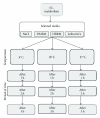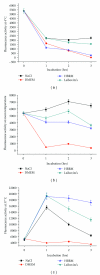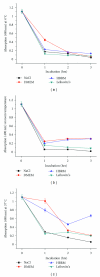Schwann cell metabolic activity in various short-term holding conditions: implications for improved nerve graft viability
- PMID: 22272205
- PMCID: PMC3261467
- DOI: 10.1155/2012/742183
Schwann cell metabolic activity in various short-term holding conditions: implications for improved nerve graft viability
Erratum in
-
Corrigendum to "Schwann Cell Metabolic Activity in Various Short-Term Holding Conditions: Implications for Improved Nerve Graft Viability".Int J Otolaryngol. 2024 Dec 26;2024:9870507. doi: 10.1155/2024/9870507. eCollection 2024. Int J Otolaryngol. 2024. PMID: 39854193 Free PMC article.
Abstract
Strategies for improvement of nerve regeneration and optimal conditions to prevent Schwann cell (SC) loss within a nerve transplant procedure are critical. The purpose of this study was to examine SC viability, which plays an important role in peripheral nerve regeneration, under various incubation conditions up to three hours. To address this issue, Schwann cell metabolic activity was determined using different independent test methods. The following experimental conditions were compared: SCs prepared from nerves were incubated in (1) isotonic saline solution (2) Dulbecco's modified Eagles medium as used for cell culturing, (3) Hannover bioreactor medium, and (4) Leibovitz's medium. SC metabolic activity of excised rat sciatic nerve was determined at 4°C, 18°C, and 37°C over 3 hrs. The results indicate that SC activity was optimized by the usage of Leibovitz's medium or HBRM at 37°C. Greater SC viability at the time of surgical nerve grafting could contribute to improved axonal regeneration and remyelination after nerve transplantation, and thus more successful functional recovery.
Figures




Similar articles
-
Enhanced in vivo survival of Schwann cells by a synthetic oxygen carrier promotes sciatic nerve regeneration and functional recovery.J Tissue Eng Regen Med. 2018 Jan;12(1):e177-e189. doi: 10.1002/term.2284. Epub 2017 Mar 30. J Tissue Eng Regen Med. 2018. PMID: 27592228
-
Adult skin-derived precursor Schwann cells exhibit superior myelination and regeneration supportive properties compared to chronically denervated nerve-derived Schwann cells.Exp Neurol. 2016 Apr;278:127-42. doi: 10.1016/j.expneurol.2016.02.006. Epub 2016 Feb 6. Exp Neurol. 2016. PMID: 26854934
-
Limited regeneration in long acellular nerve allografts is associated with increased Schwann cell senescence.Exp Neurol. 2013 Sep;247:165-77. doi: 10.1016/j.expneurol.2013.04.011. Epub 2013 May 3. Exp Neurol. 2013. PMID: 23644284 Free PMC article.
-
Skin derived precursor Schwann cells improve behavioral recovery for acute and delayed nerve repair.Exp Neurol. 2014 Apr;254:168-79. doi: 10.1016/j.expneurol.2014.01.002. Epub 2014 Jan 15. Exp Neurol. 2014. PMID: 24440805
-
Biomaterial-Based Schwann Cell Transplantation and Schwann Cell-Derived Biomaterials for Nerve Regeneration.Front Cell Neurosci. 2022 Jun 28;16:926222. doi: 10.3389/fncel.2022.926222. eCollection 2022. Front Cell Neurosci. 2022. PMID: 35836742 Free PMC article. Review.
Cited by
-
Corrigendum to "Schwann Cell Metabolic Activity in Various Short-Term Holding Conditions: Implications for Improved Nerve Graft Viability".Int J Otolaryngol. 2024 Dec 26;2024:9870507. doi: 10.1155/2024/9870507. eCollection 2024. Int J Otolaryngol. 2024. PMID: 39854193 Free PMC article.
-
Static image analysis as new approach for the characterization of tumor cell lysate used in dendritic cell vaccine preparation.Transfus Med Hemother. 2015 Mar;42(2):122-8. doi: 10.1159/000371480. Epub 2015 Jan 29. Transfus Med Hemother. 2015. PMID: 26019708 Free PMC article.
References
-
- Waller A. Experiments on the glossopharyngeal and hypoglossal nerves of the frog and observations produced thereby in the structure of their primitive fibers. Philosophical Transactions of the Royal Society of London. 1850;140:423–429.
-
- Johnson EM, Taniuchi M, DiStefano PS. Expression and possible function of nerve growth factor receptors on Schwann cells. Trends in Neurosciences. 1988;11(7):299–304. - PubMed
-
- Fansa H, Keilhoff G. Factors influencing nerve regeneration. Handchirurgie Mikrochirurgie Plastische Chirurgie. 2003;35(2):72–82. - PubMed
-
- Ide C. Peripheral nerve regeneration. Neuroscience Research. 1996;25(2):101–121. - PubMed
LinkOut - more resources
Full Text Sources

